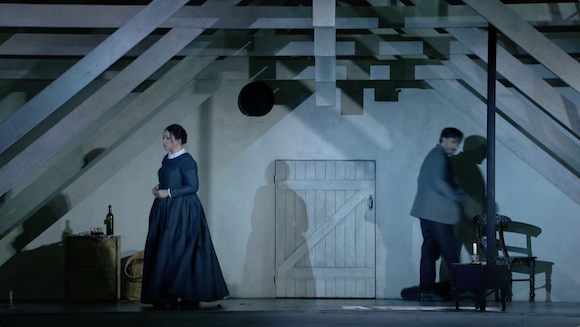Richard Jones’ production of Puccini’s La Bohème recorded at the Royal Opera House in 2020 is, at first glance, a highly conventional “traditional” La Bohème. There’s no subtext. The story unfolds strictly in line with the libretto. And yet there’s something going on that raises it above the level of the typical canary fanciers’ La Bohème. Ultimately I think it’s a combination of avoiding sentimentality or glitz or glamour and really focussing on the characters and the relationships between them. It seems that the revival direction team of Julia Burbach and Simon Iorio and the cast have really worked on this.

So what do we see? Acts 1 and 4 are set in a very plain garret. It really looks like a half finished loft. Act 3 is just as basic. The inn is little more than a hut. Only Act 2, appropriately, gets the glam treatment which only serves to point up the poverty of the other three acts. Costumes too are very basic except, again, for Musetta in Act 2. Mimi’s illness is very apparent right from her first entrance. She doesn’t just cough a bit. She looks like death warmed up and Rodolpho’s anguish at not being able to provide for her makes sense. Musetta is a bit over the top in a convincing way. In her Act 2 aria she takes her panties off and drops them on Marcello. Their rows are theatrical in the sense that they know they are both playing a part but Musetta shows real depth of feeling in Act 4. Love is a game but Death isn’t.

It’s all well executed. The singing is first rate, which one might expect in a Covent Garden Bohème, but the acting is also much better than one often sees in opera. The star is perhaps Sonya Yoncheva as Mimi. She sings her big numbers beautifully but never lets one forget that Mimi is really sick. Charles Castronovo is a very fine Rodolfo with the necessary high notes but also real chemistry with Yoncheva. Simona Mihai’s Musetta is interesting. Partly it’s that she looks terribly innocent but acts quite brazenly but then successfully manages different emotional registers in Acts 3 and 4. Her voice is lighter and brighter than Yoncheva which makes for an interesting contrast. She interacts extremely well with the powerfully sung but subtly acted Marcello of Andrzej Filonczyk. Peter Kellner, as Colline, and Gyula Nagy, as Schaunard, are effective foils and add some manic energy to the first part of Act 4.

The ROH chorus, including the children, is on good form in a pretty spectacular Act 2. Emmanuel Villaume conducts and one senses a conductor on the same page as the production. I don’t think he misses anything in bringing out the way Puccini uses the music to prefigure emotion and move the action along.
 Jonathan Haswell’s video direction is fine. The only place one wonders whether there’s more to see than he gives us is in the very busy Act 2. The picture on Blu-ray is excellent and copes well with the dark exterior scenes in Act 3. The DTS-HD-MA sound is very good with a 24bit stereo option. There are a couple of short extras on the disk. One is a set of very short cast and creative team sound bites which nonetheless convey the intent of the production and performers. There’s also five minutes on the music from Antonio Pappano who is as lucid as ever. The booklet has a pretty good essay by Alexandra Wilson plus a synopsis. Subtitle options are English, French, German, Korean and Japanese.
Jonathan Haswell’s video direction is fine. The only place one wonders whether there’s more to see than he gives us is in the very busy Act 2. The picture on Blu-ray is excellent and copes well with the dark exterior scenes in Act 3. The DTS-HD-MA sound is very good with a 24bit stereo option. There are a couple of short extras on the disk. One is a set of very short cast and creative team sound bites which nonetheless convey the intent of the production and performers. There’s also five minutes on the music from Antonio Pappano who is as lucid as ever. The booklet has a pretty good essay by Alexandra Wilson plus a synopsis. Subtitle options are English, French, German, Korean and Japanese.

I wasn’t especially looking forward to watching what appeared from the packaging to be an entirely traditional La Bohème but I was pleasantly surprised. By refusing to fall to the allure of superficial glitz, Richard Jones gets to the heart of the relationships between the characters and creates something that really works as theatre. It doesn’t bridge emotional past and present like the brilliant Herheim production but it is very satisfying. It’s also top notch musically which the Oslo production isn’t quite. I’m now curious to see how this compares with the same production recorded a couple of years earlier with Pappano conducing, Nicole Car as Mimi and Michael Fabiano as Rodolfo; not least because Fabiano is the best Rodolfo I’ve heard live. In any event I think most people would enjoy this disk though it won’t change your view of La Bohème the way Herheim does.


Pingback: The other ROH La Bohème | operaramblings